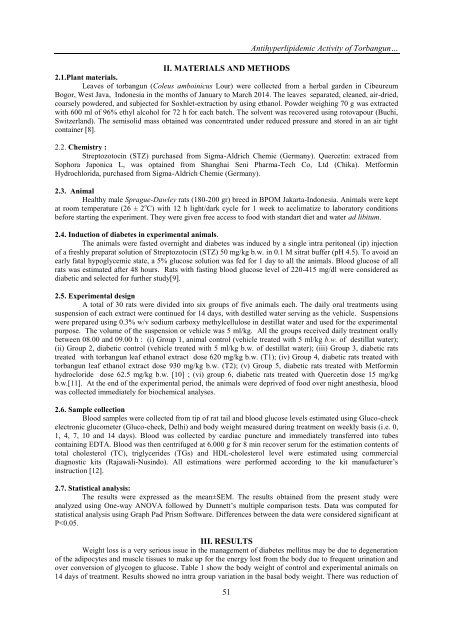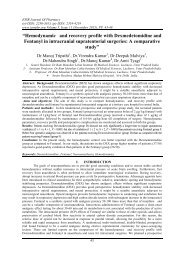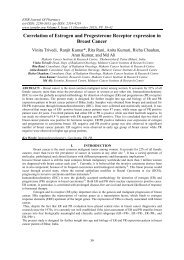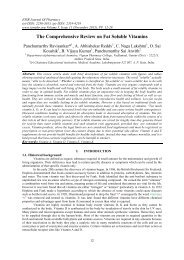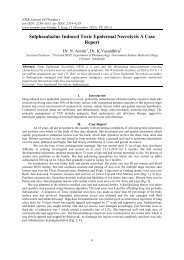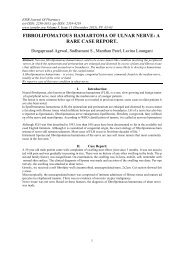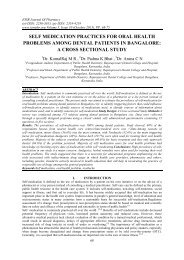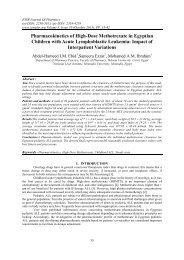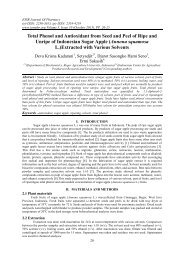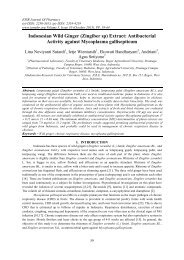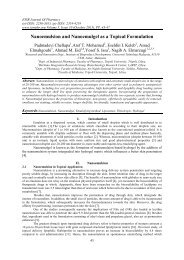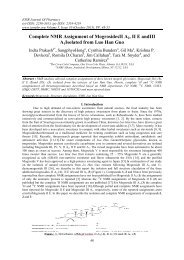Antihyperlipidemic Activity of Torbangun Extract (Coleus amboinicus Lour) on Diabetic Rats Induced by Streptozotocin
Create successful ePaper yourself
Turn your PDF publications into a flip-book with our unique Google optimized e-Paper software.
51<br />
<str<strong>on</strong>g>Antihyperlipidemic</str<strong>on</strong>g> <str<strong>on</strong>g>Activity</str<strong>on</strong>g> <str<strong>on</strong>g>of</str<strong>on</strong>g> <str<strong>on</strong>g>Torbangun</str<strong>on</strong>g>…<br />
II. MATERIALS AND METHODS<br />
2.1.Plant materials.<br />
Leaves <str<strong>on</strong>g>of</str<strong>on</strong>g> torbangun (<str<strong>on</strong>g>Coleus</str<strong>on</strong>g> <str<strong>on</strong>g>amboinicus</str<strong>on</strong>g> <str<strong>on</strong>g>Lour</str<strong>on</strong>g>) were collected from a herbal garden in Cibeureum<br />
Bogor, West Java, Ind<strong>on</strong>esia in the m<strong>on</strong>ths <str<strong>on</strong>g>of</str<strong>on</strong>g> January to March 2014. The leaves separated, cleaned, air-dried,<br />
coarsely powdered, and subjected for Soxhlet-extracti<strong>on</strong> <strong>by</strong> using ethanol. Powder weighing 70 g was extracted<br />
with 600 ml <str<strong>on</strong>g>of</str<strong>on</strong>g> 96% ethyl alcohol for 72 h for each batch. The solvent was recovered using rotovapour (Buchi,<br />
Switzerland). The semisolid mass obtained was c<strong>on</strong>centrated under reduced pressure and stored in an air tight<br />
c<strong>on</strong>tainer [8].<br />
2.2. Chemistry :<br />
<strong>Streptozotocin</strong> (STZ) purchased from Sigma-Aldrich Chemie (Germany). Quercetin: extraced from<br />
Sophora Jap<strong>on</strong>ica L, was optained from Shanghai Seni Pharma-Tech Co, Ltd (Chika). Metformin<br />
Hydrochlorida, purchased from Sigma-Aldrich Chemie (Germany).<br />
2.3. Animal<br />
Healthy male Sprague-Dawley rats (180-200 gr) breed in BPOM Jakarta-Ind<strong>on</strong>esia. Animals were kept<br />
at room temperature (26 ± 2 o C) with 12 h light/dark cycle for 1 week to acclimatize to laboratory c<strong>on</strong>diti<strong>on</strong>s<br />
before starting the experiment. They were given free access to food with standart diet and water ad libitum.<br />
2.4. Inducti<strong>on</strong> <str<strong>on</strong>g>of</str<strong>on</strong>g> diabetes in experimental animals.<br />
The animals were fasted overnight and diabetes was induced <strong>by</strong> a single intra perit<strong>on</strong>eal (ip) injecti<strong>on</strong><br />
<str<strong>on</strong>g>of</str<strong>on</strong>g> a freshly preparat soluti<strong>on</strong> <str<strong>on</strong>g>of</str<strong>on</strong>g> <strong>Streptozotocin</strong> (STZ) 50 mg/kg b.w. in 0.1 M sitrat buffer (pH 4.5). To avoid an<br />
early fatal hypoglycemic state, a 5% glucose soluti<strong>on</strong> was fed for 1 day to all the animals. Blood glucose <str<strong>on</strong>g>of</str<strong>on</strong>g> all<br />
rats was estimated after 48 hours. <strong>Rats</strong> with fasting blood glucose level <str<strong>on</strong>g>of</str<strong>on</strong>g> 220-415 mg/dl were c<strong>on</strong>sidered as<br />
diabetic and selected for further study[9].<br />
2.5. Experimental design<br />
A total <str<strong>on</strong>g>of</str<strong>on</strong>g> 30 rats were divided into six groups <str<strong>on</strong>g>of</str<strong>on</strong>g> five animals each. The daily oral treatments using<br />
suspensi<strong>on</strong> <str<strong>on</strong>g>of</str<strong>on</strong>g> each extract were c<strong>on</strong>tinued for 14 days, with destilled water serving as the vehicle. Suspensi<strong>on</strong>s<br />
were prepared using 0.3% w/v sodium carboxy methylcellulose in destillat water and used for the experimental<br />
purpose. The volume <str<strong>on</strong>g>of</str<strong>on</strong>g> the suspensi<strong>on</strong> or vehicle was 5 ml/kg. All the groups received daily treatment orally<br />
between 08.00 and 09.00 h : (i) Group 1, animal c<strong>on</strong>trol (vehicle treated with 5 ml/kg b.w. <str<strong>on</strong>g>of</str<strong>on</strong>g> destillat water);<br />
(ii) Group 2, diabetic c<strong>on</strong>trol (vehicle treated with 5 ml/kg b.w. <str<strong>on</strong>g>of</str<strong>on</strong>g> destillat water); (iii) Group 3, diabetic rats<br />
treated with torbangun leaf ethanol extract dose 620 mg/kg b.w. (T1); (iv) Group 4, diabetic rats treated with<br />
torbangun leaf ethanol extract dose 930 mg/kg b.w. (T2); (v) Group 5, diabetic rats treated with Metformin<br />
hydrocloride dose 62.5 mg/kg b.w. [10] ; (vi) group 6, diabetic rats treated with Quercetin dose 15 mg/kg<br />
b.w.[11]. At the end <str<strong>on</strong>g>of</str<strong>on</strong>g> the experimental period, the animals were deprived <str<strong>on</strong>g>of</str<strong>on</strong>g> food over night anesthesia, blood<br />
was collected immediately for biochemical analyses.<br />
2.6. Sample collecti<strong>on</strong><br />
Blood samples were collected from tip <str<strong>on</strong>g>of</str<strong>on</strong>g> rat tail and blood glucose levels estimated using Gluco-check<br />
electr<strong>on</strong>ic glucometer (Gluco-check, Delhi) and body weight measured during treatment <strong>on</strong> weekly basis (i.e. 0,<br />
1, 4, 7, 10 and 14 days). Blood was collected <strong>by</strong> cardiac puncture and immediately transferred into tubes<br />
c<strong>on</strong>taining EDTA. Blood was then centrifuged at 6.000 g for 8 min recover serum for the estimati<strong>on</strong> c<strong>on</strong>tents <str<strong>on</strong>g>of</str<strong>on</strong>g><br />
total cholesterol (TC), triglycerides (TGs) and HDL-cholesterol level were estimated using commercial<br />
diagnostic kits (Rajawali-Nusindo). All estimati<strong>on</strong>s were performed according to the kit manufacturer’s<br />
instructi<strong>on</strong> [12].<br />
2.7. Statistical analysis:<br />
The results were expressed as the mean±SEM. The results obtained from the present study were<br />
analyzed using One-way ANOVA followed <strong>by</strong> Dunnett’s multiple comparis<strong>on</strong> tests. Data was computed for<br />
statistical analysis using Graph Pad Prism S<str<strong>on</strong>g>of</str<strong>on</strong>g>tware. Differences between the data were c<strong>on</strong>sidered significant at<br />
P


